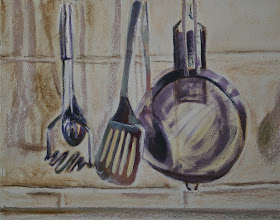The aim of this exercise was to explore the linear qualities of a simple still life arrangement of household objects in their usual position. I was attracted to the kitchen utensils hanging on the tiled kitchen wall.
I first made some small sketches starting with blind drawings and continuous line drawings:
I played around with composition in my A3 sketchbook and tried painting the linear elements with black paint. I realised that what I liked about my initial sketches was the quality of line that comes from continuous or blind drawing. I found it wasn't really possible get this when painting with a brush and paint (rather than ink) because I kept having to reload the brush (so lost the flow of continuous line.
I tried loading diluted paint into a syringe and drawing with a needle attached - this didn't work as well as it had in my previous experiment in 'Drawing 1' with ink because the paint was much thicker and took more force to squeeze through the needle. I also had to have the needle in contact with the paper which was textured - the result was a rather juddery line - a long way from the confident continuous line drawing.
I went back to pen for working out the composition - these sketches are in my A3 sketchbook. I was happy to lose accuracy for the sake of flowing lines - the top one is with a sharpie marker pen and the bottom one with a finer drawing pen:
Next I followed the instructions in the exercise - I drew the linear elements of the composition on Bockingford watercolour paper (A2) using a brush and gouache and them worked back into this with gouache (and a bit of soft pastel in the background). It really wasn't working. It all felt very static and dull compared to the interest of the initial sketches. I also realised that this didn't emphasise the linear qualities of the objects as had been my original intention - I needed another approach.
I had a brainwave! I had enjoyed drawing by squirting ink at the page in my previous course and thought that a way of getting a similar sensation with paint could be to use spray paint so I went to the local hardware shop and bough myself a spray can.
I developed a greater respect for urban graffiti artists as I grappled with trying to draw with this somewhat uncooperative item! I also developed a banging headache despite wearing a mask and working in a well ventilates area with a a fan drawing the fumes out of the window - I think this might become summer activity so I can work outdoors.
I did a few practice sketches on A2 paper. This definitely works better the larger the paper The thickness of line can be varied depending on the distance of the nozzle from the paper but remains quite bold even at the closest position:
Finally I drew my composition in spray paint on a sheet of A1 cartridge paper. Having established the linear elements in bold lines with the paint I then worked back into it with oil bars and oil pastels to establish areas of flat colour such at the tiles and the bright reflections from these metallic objects. I kept it quite simple; making no attempt to establish finely modelled surfaces - in this way the freshness and linearity was better maintained. I feel this painting is more successful than the gouache one on Bockingford paper. It has a more dynamic feel to it. Obviously the drawing is less accurate but I don't think that detracts - it probably adds to the feel that it was executed rapidly and is therefore more dynamic.







No comments:
Post a Comment